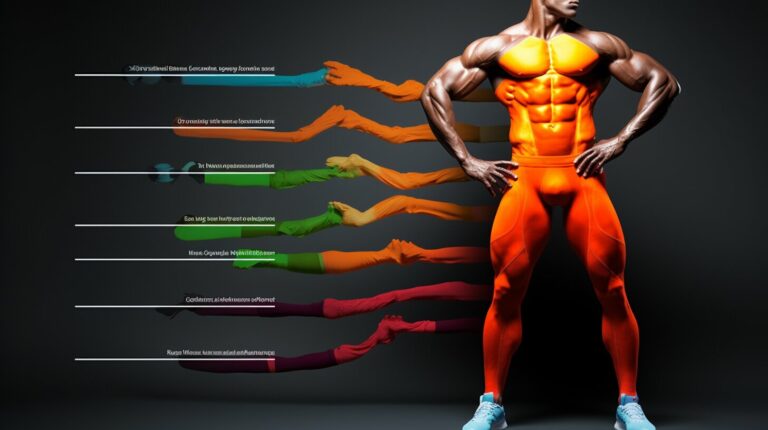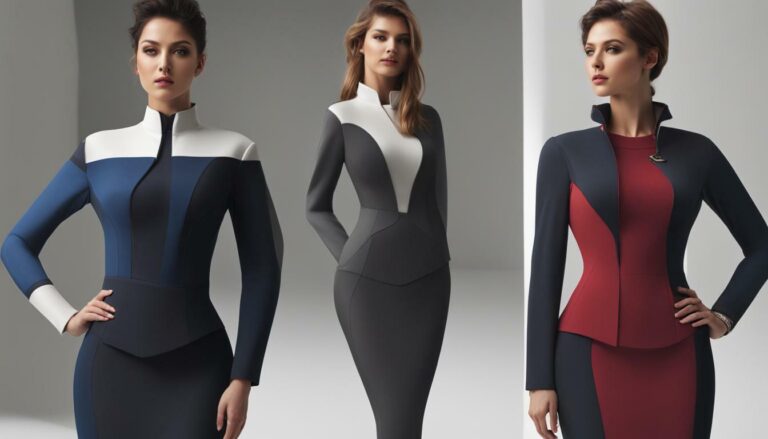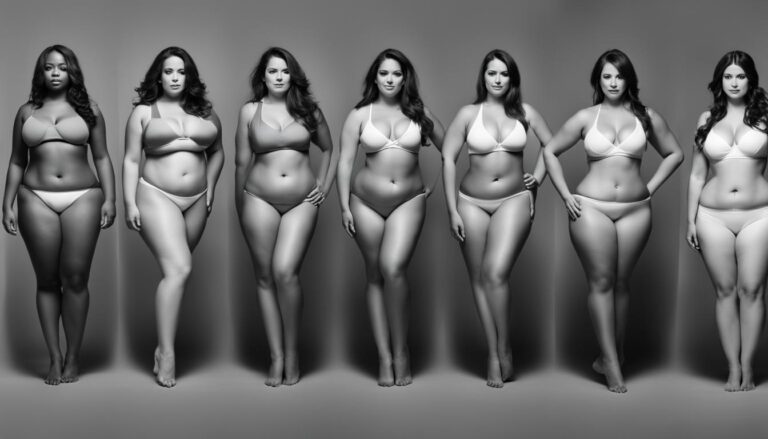Where do Dramatics Gain Weight?
Weight gain can affect individuals in different ways, and the same goes for dramatic individuals. While weight gain does not change your Kibbe Image ID, it can make it more evident where your weight tends to congregate. Understanding the specific weight gain patterns for dramatic individuals can help in managing weight gain and maintaining a healthy lifestyle.
The Kibbe body system categorizes individuals into different Image IDs based on their bone structure, flesh, and facial features. Each ID has unique characteristics, including specific weight gain patterns. For dramatic individuals, weight gain often occurs in the hip and upper thigh area, while for soft dramatic individuals, weight gain can be seen in the bust, hips, waist, upper thighs, upper arms, and face.
Key Takeaways:
- Dramatic weight gain does not change your Kibbe Image ID.
- Understanding weight gain patterns in dramatic individuals can help in managing weight effectively.
- Weight gain in dramatics tends to occur in the hip and upper thigh area.
- Soft dramatic individuals may experience weight gain in multiple areas such as the bust, hips, waist, upper thighs, upper arms, and face.
- Maintaining a healthy lifestyle is essential for managing weight gain in dramatic individuals.
Understanding the Kibbe Image Identity System
The Kibbe Image Identity System, developed by David Kibbe in the 1980s, categorizes individuals into 13 style types based on their physical characteristics and personality essence. Unlike traditional body shape theories, which emphasize balance and symmetry, the Kibbe system aims to create a harmonious style image that considers the individual’s entire body and embraces self-love and personal style.
To determine your Kibbe ID, your bone structure, flesh, and facial features are evaluated for their balance of yin (soft, rounded) and yang (angular, straight). Each ID has unique characteristics and requires different approaches to styling individual body parts in order to create a cohesive and harmonious overall image.
The Kibbe Image Identity System goes beyond simply categorizing individuals based on their body types. It takes into account their personality essence, recognizing that style is not just a matter of appearance, but also a reflection of one’s inner self. By understanding their physical characteristics and personality essence, individuals can fully embrace their unique style and create a visual representation that is true to themselves.
The Kibbe Image Identity System focuses on creating an overall harmonious style image that celebrates individuality and self-expression.
Whether you have a soft Yin body type or a sharp Yang bone structure, the Kibbe system offers guidance on how to emphasize your natural features and create a style that resonates with your authentic self. It’s not about conforming to societal beauty standards or hiding perceived flaws, but about embracing your unique characteristics and celebrating them through your personal style.
The Benefits of the Kibbe Image Identity System
- Helps you understand your body’s unique characteristics
- Provides guidance on how to highlight your best features
- Encourages self-acceptance and self-love
- Supports the development of a personal style that aligns with your inner essence
- Offers a holistic approach to style that goes beyond body shape
By understanding the Kibbe Image Identity System, individuals can gain insights into their physical characteristics, personality essence, and how to create a style that is truly their own. It’s a system that celebrates diversity and empowers individuals to embrace their uniqueness, creating a harmonious style image that reflects their authentic selves.
In the next section, we will explore the effects of weight gain on different Kibbe IDs. Stay tuned!
The Effect of Weight Gain on Kibbe IDs
According to David Kibbe, weight gain does not change your Kibbe ID. The system takes into account your bone structure and how your flesh lays on your bones, which remains relatively constant regardless of weight changes. However, weight gain can make your ID more evident by highlighting where your weight tends to congregate.
Each Kibbe ID has specific weight gain patterns, such as heaviness in certain body areas or changes in body shape. Understanding these patterns can help individuals manage their weight and maintain a healthy lifestyle.
For example, Dramatic individuals may see weight gain around the hip and upper thigh area. Soft Classic individuals may experience weight gain in the waist and hips, while Romantic individuals tend to gain weight in the bust and thigh area. These patterns, along with others specific to each Kibbe ID, help determine how weight gain affects the overall body structure.
It’s important to note that weight gain patterns should not be the sole factor in determining your Kibbe ID. Other factors like bone structure and facial features also play a role. Weight gain is just one aspect to consider when understanding your body and how to best style it.
Weight Gain Patterns for Kibbe IDs
| Kibbe ID | Weight Gain Patterns |
|---|---|
| Dramatic | Heaviness in hip and upper thigh area |
| Natural | Overall gain with extra weight in the middle region |
| Classic | Weight gain in the waist and hips |
| Gamine | Weight gain in the lower hips and thighs |
| Romantic | Weight gain in the bust and thigh area |
| Soft Dramatic | Weight gain in the bust, hips, waist, upper thighs, upper arms, and face |
| Soft Natural | Overall gain with extra weight in the middle region and upper arms |
| Soft Classic | Weight gain in the waist and hips |
| Theatrical Romantic | Weight gain in the bust and thigh area with a softer overall gain |
| Flamboyant Natural | Overall gain with extra weight in the middle region and lower hips |
| Flamboyant Gamine | Weight gain in the lower hips and thighs with a more angular overall gain |
| Dramatic Classic | Weight gain in the hip and upper thigh area with a more balanced overall gain |
| Theatrical | Heaviness in certain body areas with a more balanced overall gain |
Understanding the weight gain patterns for each Kibbe ID can provide valuable insight into how weight affects body structure and where to focus efforts for weight management. By recognizing these patterns and considering other factors like bone structure and facial features, individuals can better understand their bodies and make informed decisions about style and self-expression.
Weight Gain Patterns for Each Kibbe ID
The weight gain patterns for each Kibbe ID can provide valuable insights into how weight affects different body types. While weight gain does not alter your Kibbe ID, it can accentuate certain areas and impact overall body shape. Understanding these patterns can help individuals better manage their weight and make informed style choices.
1. Dramatic
Dramatic individuals tend to experience weight gain around the hip and upper thigh area. This can result in a more pronounced hourglass figure, with a smaller waist and shapely hips. The weight gain in these areas may create a curvier silhouette, maintaining the overall balance of the Dramatic body type.
2. Soft Dramatic
Soft Dramatic individuals may see weight gain in multiple areas, including the bust, hips, waist, upper thighs, upper arms, and face. The additional weight can enhance the softness and femininity of the body shape. It’s important to note that Soft Dramatic individuals may still maintain angular features despite the weight gain.
3. Natural
Natural individuals typically have a more athletic and broader body structure. When they gain weight, it is often distributed evenly throughout the body. This can result in a more muscular and robust appearance, while still maintaining the overall balance and harmony of the Natural body type.
4. Soft Natural
Soft Natural individuals tend to gain weight in a similar manner to Natural types, with a more even distribution throughout the body. However, the Soft Natural body type maintains a softer and more rounded appearance, even with weight gain. The weight may accentuate the curves and create a more voluptuous silhouette.
5. Classic
Classic individuals have a balanced and proportionate body shape. When they gain weight, it is typically distributed evenly throughout the body, maintaining the overall harmony of the Classic silhouette. The weight gain may result in a slightly fuller figure without significantly altering the body proportions.
6. Soft Classic
Soft Classic individuals also experience weight gain in a proportional manner. The weight tends to distribute evenly throughout the body, maintaining the soft and rounded features of the Soft Classic body type. The weight gain may enhance the curves and create a more feminine appearance.
7. Flamboyant Natural
Flamboyant Natural individuals have a more angular and muscular body structure. When they gain weight, it may result in a more robust and athletic appearance, without compromising the overall balance and angularity of the Flamboyant Natural body type.
8. Gamine
Gamine individuals typically have a petite and compact body structure. When they gain weight, it is often distributed evenly throughout the body, maintaining the overall proportions and unique charm of the Gamine body type.
9. Soft Gamine
Soft Gamine individuals may experience weight gain in the bust and hip areas. The weight may accentuate the curves and create a more shapely silhouette, while still maintaining the delicate and playful essence of the Soft Gamine body type.
10. Theatrical Romantic
Theatrical Romantic individuals have a delicate and hourglass-shaped body structure. When they gain weight, it may emphasize the curves and result in a more voluptuous and feminine appearance, while still maintaining the overall harmony and grace of the Theatrical Romantic body type.
11. Romantic
Romantic individuals also tend to gain weight in a manner that enhances the softness and femininity of their body shape. The weight gain may primarily occur in the bust, hips, and waist, creating a more curvaceous and sensual silhouette.
12. Flamboyant Gamine
Flamboyant Gamine individuals typically have a petite and angular body structure. When they gain weight, it may result in a more athletic and toned appearance, without compromising the overall balance and sharpness of the Flamboyant Gamine body type.
13. Ingenue
Ingenue individuals have a delicate and youthful body structure. When they gain weight, it may accentuate the softness and create a fuller, softer appearance, without significantly altering the overall proportions and innocence of the Ingenue body type.
Understanding the weight gain patterns for each Kibbe ID can help individuals embrace their unique body shapes and make informed style choices that enhance their natural beauty and self-expression.
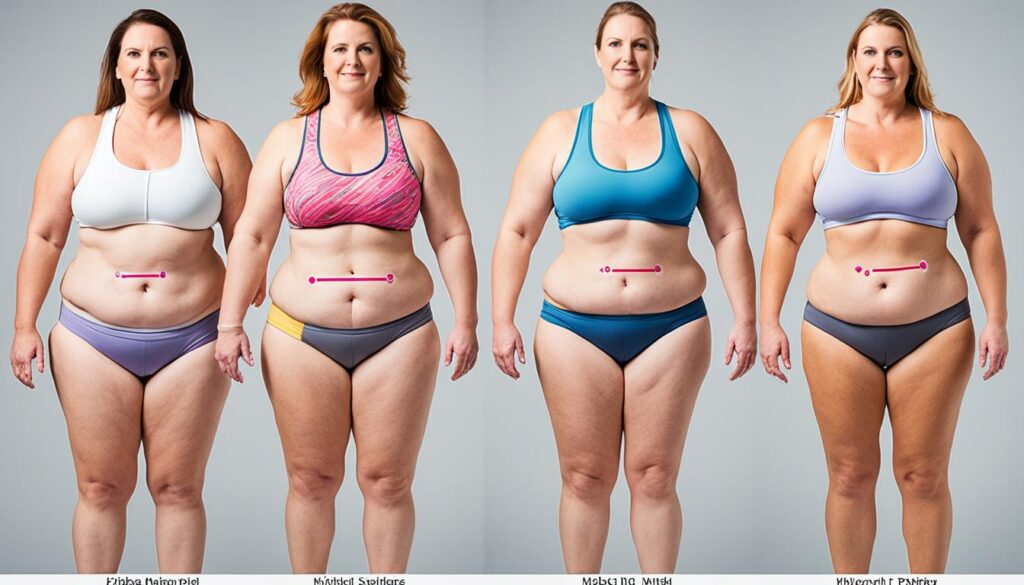
Factors to Consider in Determining Your Kibbe ID
While weight gain patterns can provide clues about your Kibbe ID, it’s important to consider other factors as well. These factors include your bone structure, facial features, body proportions, body shape, and even your style essence. Age, hormones, and pregnancy can also influence how your body carries and gains weight. I recommend waiting until you’re at least 25 years old before trying to determine your Kibbe ID, as your body is still developing before that age. Understanding these factors can help you narrow down your Kibbe ID and make more informed style choices.
To determine your Kibbe ID, you need to assess various aspects of your physical characteristics:
- Bone Structure: Look at the shape and size of your bones, such as your shoulders, hips, and facial structure.
- Facial Features: Consider the shape of your face, the prominence of your cheekbones, and the angles of your jawline.
- Body Proportions: Examine the proportions of your body, including the length of your torso, legs, and arms.
- Body Shape: Determine if your body has more rounded or angular lines, and if you have a defined waistline or not.
- Style Essence: Reflect on your personal style preferences, whether you are drawn to feminine, edgy, or relaxed looks.
By considering these factors, you can gain a better understanding of your unique attributes and how they align with the different Kibbe ID categories. Remember, determining your Kibbe ID is not about fitting into a predefined mold, but rather embracing your individuality and finding a style that enhances your natural beauty.
Celebrity Examples of Weight Gain in Kibbe IDs
Weight gain affects individuals of all body types, including those categorized within the Kibbe Image Identity System. Celebrities, in particular, provide visual examples of how weight gain can impact different Kibbe IDs. Let’s explore a few notable cases.
Example 1: Marilyn Monroe (Soft Classic)
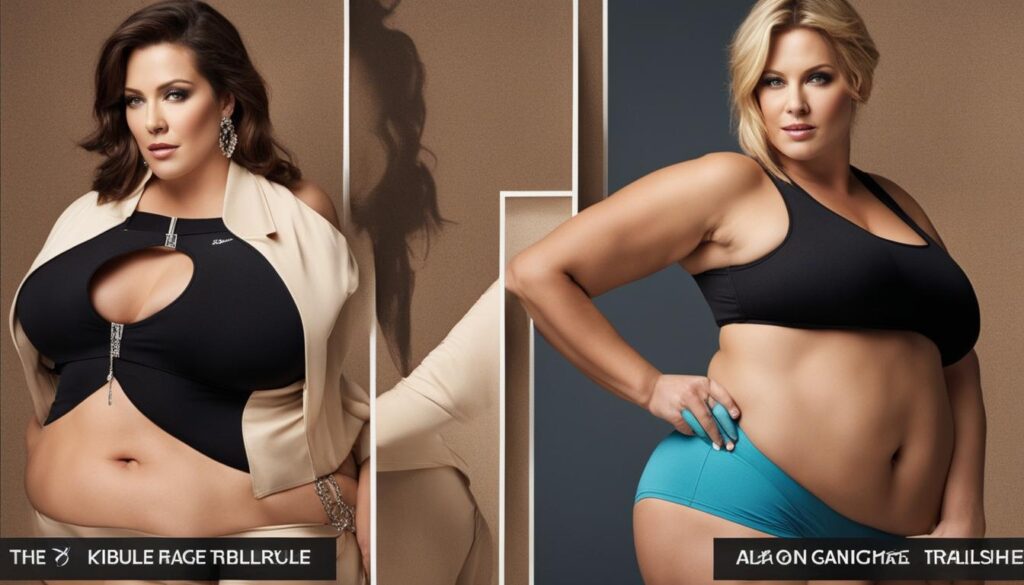
Marilyn Monroe, an iconic figure known for her hourglass figure, represents the Soft Classic Kibbe ID. Though she was often portrayed as the epitome of glamour and sensuality, Monroe struggled with weight fluctuations throughout her career. Her weight gain primarily affected her bust, waist, and hips, emphasizing the soft, feminine curves associated with the Soft Classic body type.
Example 2: Tom Hanks (Soft Natural)
Tom Hanks, a versatile actor, has been identified as a Soft Natural through the Kibbe system. Over the years, Hanks has experienced weight gain, particularly in the midsection. This aligns with the weight gain patterns observed in Soft Natural individuals, who tend to gain weight around the waist, giving them a softer, rounded appearance.
Example 3: Adele (Theatrical Romantic)
Adele, a renowned singer and songwriter, falls under the Theatrical Romantic Kibbe ID. Throughout her career, Adele has embraced her curves, even experiencing weight gain at times. As a Theatrical Romantic, she may see weight gain in multiple areas, including the bust, hips, waist, and upper arms. This weight gain contributes to her signature feminine and voluptuous physique.
“Weight gain can be a natural part of life for individuals of all body types, including celebrities. It’s important to remember that weight gain does not define one’s beauty or worth.”
These celebrity examples illustrate how weight gain can manifest differently in various Kibbe IDs. Whether it accentuates the curves of a Soft Classic, softens the lines of a Soft Natural, or enhances the femininity of a Theatrical Romantic, weight gain highlights the diverse range of body shapes within the Kibbe system.
| Celebrity | Kibbe ID | Weight Gain Patterns |
|---|---|---|
| Marilyn Monroe | Soft Classic | Bust, waist, hips |
| Tom Hanks | Soft Natural | Midsection, waist |
| Adele | Theatrical Romantic | Bust, hips, waist, upper arms |
These examples serve as a reminder that weight gain is a natural part of life and that beauty comes in all shapes and sizes. Embracing one’s unique body type and celebrating it is the essence of the Kibbe system.
Conclusion
Understanding how weight gain affects different Kibbe IDs is essential for individuals to embrace their unique body shapes and make informed style choices. While weight gain does not change your Kibbe ID, it can accentuate specific areas of the body and alter body proportions. By recognizing these patterns and understanding the distinctive characteristics of each Kibbe ID, individuals can effectively manage their weight and maintain a healthy lifestyle.
The Kibbe system is not about attaining a specific body shape or concealing flaws; it encourages individuals to embrace their individual style essence and create a harmonious overall image. By considering factors such as bone structure, facial features, body proportions, and style essence, individuals can determine their Kibbe ID more accurately and make style choices that flatter their unique attributes.
Weight gain in the context of Kibbe IDs demonstrates the diversity of body shapes and how weight distribution varies among individuals. Whether weight gain concentrates in the hip and upper thigh area for Dramatic individuals or in the bust and hip areas for Soft Gamine individuals, understanding these patterns empowers individuals to navigate their personal style journeys with confidence and authenticity. By taking a comprehensive approach to style and embracing self-love, individuals can redefine beauty standards and celebrate their bodies in all their forms.
FAQ
Where do dramatics gain weight?
Dramatics tend to gain weight in the hip and upper thigh area. Soft Dramatics may also experience weight gain in the bust, hips, waist, upper thighs, upper arms, and face.
Does weight gain change your Kibbe ID?
No, weight gain does not change your Kibbe ID. The system takes into account your bone structure and how your flesh lays on your bones, which remains relatively constant regardless of weight changes. However, weight gain can make your ID more evident by highlighting where your weight tends to congregate.
What are weight gain patterns for each Kibbe ID?
The weight gain patterns for each Kibbe ID vary. Dramatics tend to gain weight in the hip and upper thigh area, while Soft Dramatics may experience weight gain in multiple body areas including the bust, hips, waist, upper thighs, upper arms, and face.
What factors should I consider in determining my Kibbe ID?
When determining your Kibbe ID, you should consider factors such as your bone structure, facial features, body proportions, body shape, and style essence. Additionally, age, hormones, and pregnancy can also influence how your body carries and gains weight.
Are there any celebrity examples of weight gain in different Kibbe IDs?
Yes, many celebrities have been categorized into different Kibbe IDs and have experienced weight gain throughout their careers. These examples can provide visual representations of how weight affects different Kibbe body types and highlight the diversity of body shapes.


